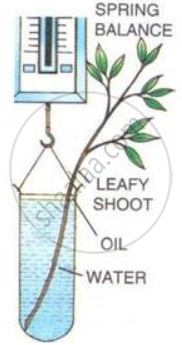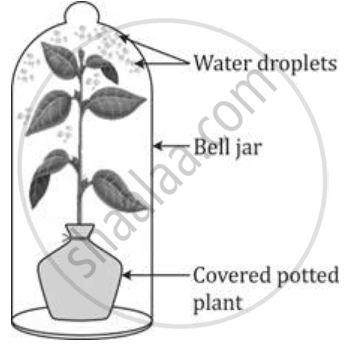Advertisements
Advertisements
प्रश्न
Plants show temporary and permanent wilting. Differentiate between the two. Do any of them indicate the water status of the soil?
उत्तर
| Temporary Wilting | Permanent Wilting |
| (i) There is a temporary loss of turgidity in cells. | (i) There is permanent loss of turgidity in cells. |
| (ii) This happens when the rate of | (ii) This happens when the rate of transpiration is more than the rate of water supply Then the rate of water supply. But the difference is below a critical level. |
| (iii) Wilting disappears as soon as the water supply resumes to normal. | (iii) Wilting does not disappear even after the water supply resumes to normal. |
| (iv) Plant recovers its normal activity. | (iv) Plant eventually dies. |
APPEARS IN
संबंधित प्रश्न
An apparatus, as shown below, was set up to investigate a physiological process in plants. The setup was kept in sunlight for two hours. Droplets of water were then seen inside the bell jar. Answer the questions that follow:

- Name the process being studied.
- Explain the process named above in Q.3(a)(i).
- Why was the pot covered with a plastic sheet?
- Suggest a suitable control for this experiment.
- Mention two ways in which this process is beneficial to plants.
- List three adaptations in plants to reduce the above mentioned process.
The loss of water in the form of water vapour through stomata on leaves is known as ___________.
The set up shown alongside was kept in sunlight for an hour. It was observed that drops of water appeared on the inside of the polyethylene bag.

- Name the process which is being demonstrated.
- Why was the pot and its soil left uncovered by the polythene bag?
- Why was the pot left in the sunlight?
- Suppose the pot in this experiment was placed inside a dark room instead of placing it in sunlight for some time. What difference will be noticed?
How does transpiration help the roots absorb water and minerals from the soil?
Define the three processes by which plants absorb water and minerals from the soil.
Give suitable explanation for the following:
Perspiration and transpiration help to cool the body temperature of the organism.
Given alongside is the diagram of an experimental set-up to demonstrate a certain phenomenon in plants.

What is the purpose of the spring balance in the set-up?
An apparatus as shown below was set up to investigate a physiological process in plants. The setup was kept in sunlight for two hours. Droplets of water were then seen inside the bell jar. Answer the questions that follow:

Mention two ways in which this process is beneficial to plants.
Design an experiment to demonstrate the transpiration process.
A root hair is derived from ______ cell.
